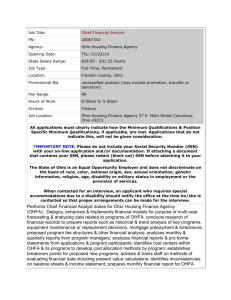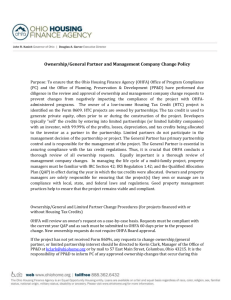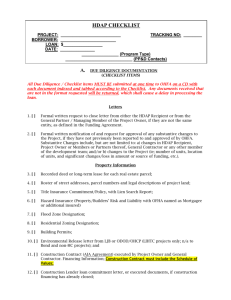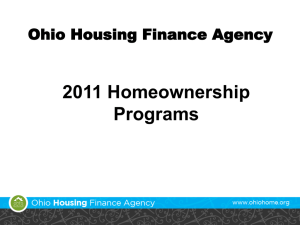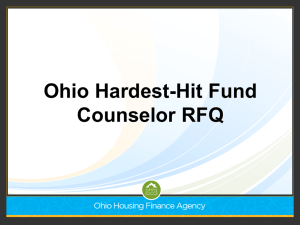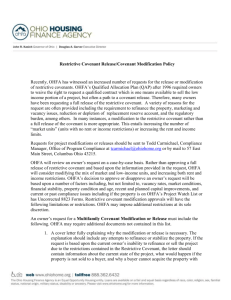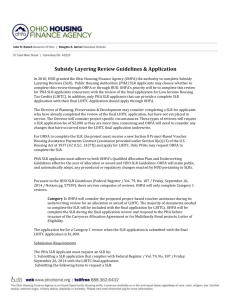Multifamily Underwriting Guidelines
advertisement
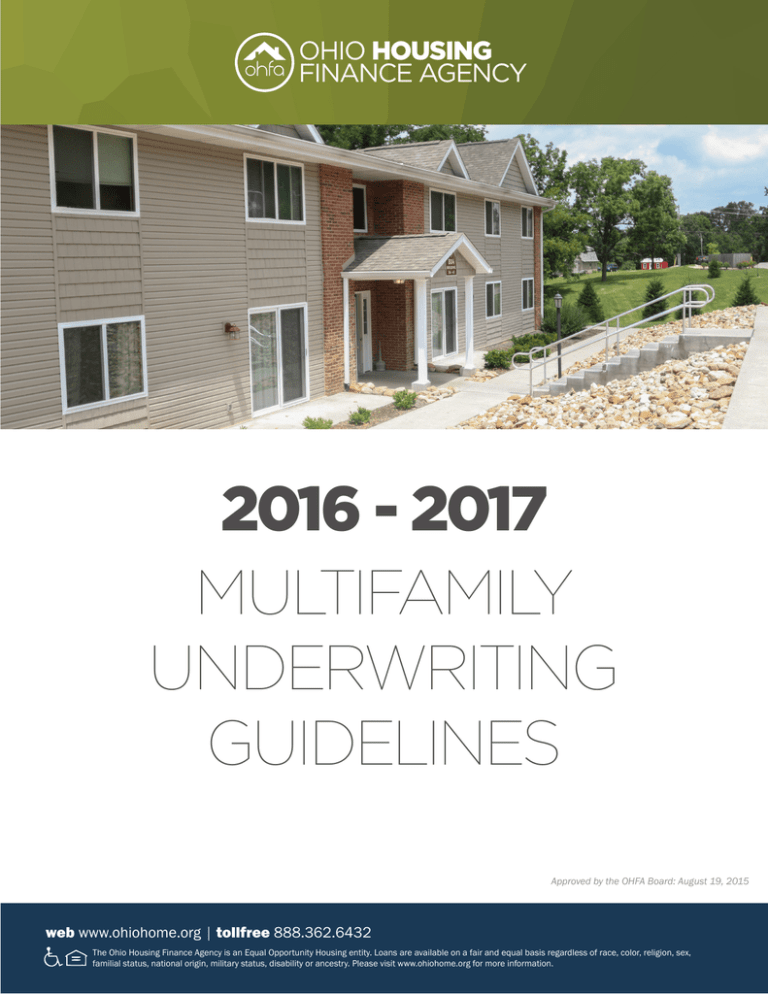
OHIO HOUSING FINANCE AGENCY 2016 - 2017 MULTIFAMILY UNDERWRITING GUIDELINES Approved by the OHFA Board: August 19, 2015 web www.ohiohome.org | tollfree 888.362.6432 The Ohio Housing Finance Agency is an Equal Opportunity Housing entity. Loans are available on a fair and equal basis regardless of race, color, religion, sex, familial status, national origin, military status, disability or ancestry. Please visit www.ohiohome.org for more information. OHIO HOUSING FINANCE AGENCY Table of Contents Introduction..................................................................................................................... 4 Competitive (9%) Housing Tax Credits Underwriting Process...................................................................................4 Non-Competitive (4%) Housing Tax Credits Underwriting Process............................................................................4 OHFA Gap Financing Programs (HDGF, CIP, CFEHI Underwriting Process)...............................................................4 I. Development Budget................................................................................................ 5 A. Development Budget Overview...............................................................................................................................5 1. Cost Reasonableness.........................................................................................................................................5 2. Sources and Uses...............................................................................................................................................5 3. Other Line Items..................................................................................................................................................5 B. Acquisition and Land Costs.....................................................................................................................................5 C. Related Party Acquisitions.......................................................................................................................................5 D. Construction Related Costs ...................................................................................................................................6 1. Hard Construction Costs.....................................................................................................................................6 2. Rehab Minimum Hard Construction .................................................................................................................6 3. Construction Interest .........................................................................................................................................6 4. Construction Contingencies ..............................................................................................................................6 5. Contractor’s Cost Limits ....................................................................................................................................6 6. Construction Cost Savings..................................................................................................................................6 E. Professional Soft Costs............................................................................................................................................7 1. Professional Soft Costs.......................................................................................................................................7 2. Professional Soft Cost Limits ............................................................................................................................7 3. Professional Soft Cost Contingencies ..............................................................................................................7 4. Developer Fees ...................................................................................................................................................7 F. Reserves....................................................................................................................................................................8 1. Operating Reserves ...........................................................................................................................................8 2. Replacement Reserves .....................................................................................................................................8 3. Special Reserves ...............................................................................................................................................8 II. Development Financing.......................................................................................... 9 A. All Sources Identified .............................................................................................................................................9 B. Commitment Letters................................................................................................................................................9 1. Equity Commitment ..........................................................................................................................................9 2. Debt Financing ..................................................................................................................................................9 3. Other Commitment Letters ................................................................................................................................9 C. Deferred Developer’s Fee .......................................................................................................................................9 III. Income and Expense Analysis.............................................................................. 10 A. Income and Expense Overview...............................................................................................................................10 1. Operating Expense Reasonableness.................................................................................................................10 2. Vacancy ...............................................................................................................................................................10 3. Income/Expense Escalations ..........................................................................................................................10 4. Lease Option Agreements..................................................................................................................................10 B. Expenses..................................................................................................................................................................10 1. Utility Allowances................................................................................................................................................10 2. Syndicator Expenses ..........................................................................................................................................10 3. Service Coordination Expenses and Fees ........................................................................................................10 PAGE 2 WWW.OHIOHOME.ORG 2016 - 20 17 M U L T I F A M I L Y U N D E R W R I T I N G G U I D E L I N E S C. Income......................................................................................................................................................................11 1. Rental Income ...................................................................................................................................................11 2. Commercial Income ...........................................................................................................................................11 3. Other Income ......................................................................................................................................................11 D. Debt Coverage Ratio ...............................................................................................................................................11 E. Subsidy Layering Review .........................................................................................................................................11 IV. Credit Calculation (Tax Credit Developments Only).................................... 12 A. Tax Credit Percentage ............................................................................................................................................12 B. Eligible Basis ..........................................................................................................................................................12 C. Acquisition Basis ....................................................................................................................................................12 V. Development Changes............................................................................................ 13 888.362.6432 PAGE 3 OHIO HOUSING FINANCE AGENCY Introduction In accordance with the Ohio Housing Finance Agency’s (OHFA) policy and state and federal requirements, OHFA will perform underwriting analysis on all proposal applications that request an award of any OHFA resources. Each evaluation will consist of a review of the financing sources, development budget, income and operating expenses and a cash flow analysis. The underwriting process and standards are designed to ensure that OHFA awards the minimum amount of subsidy necessary for the successful development of affordable housing that meets the goals of OHFA’s Annual Plan. OHFA reserves the right to request further clarification, justification or documentation for any questions that are identified during the underwriting analysis. At its discretion, OHFA may reduce, alter or remove items that do not meet the underwriting standards in these guidelines. Developments must meet OHFA standards, unless an exception is clearly indicated. Exceptions must be submitted with the proposal application. OHFA reserves the right to deny any application that does not meet the underwriting standards in these guidelines. The Multifamily Underwriting Guidelines may be subject to change, pending developments in federal and state legislative requirements and/or OHFA policy. Unless otherwise approved by OHFA, the Multifamily Underwriting Guidelines will be used beginning with all 2016 funding rounds. Developments will be underwritten based on the funding source being applied for: Competitive (9%) Housing Tax Credits Underwriting Process All developments applying for an allocation of competitive 9% housing tax credits (with or without OHFA gap financing) undergo an underwriting review three times: • At proposal submission to determine if they are eligible to continue in the competitive process; • At final application prior to issuing a Carryover Allocation Agreement; and • At the time the development is placed-in-service and requests IRS Form(s) 8609. Non-Competitive (4%) Housing Tax Credits Underwriting Process All developments applying for an allocation of 4% housing tax credits will undergo an underwriting review at application prior to issuing a 42m Letter of Eligibility. A final underwriting review will take place at the time the development is placed-in-service and requests IRS Form(s) 8609. OHFA Gap Financing Programs (HDGF, CIP, CFEHI Underwriting Process) All developments requesting OHFA gap financing, including Housing Development Assistance Program (HDAP) resources, will undergo an underwriting review at proposal and again at the time of final application, if applicable. PAGE 4 WWW.OHIOHOME.ORG 2016 - 20 17 M U L T I F A M I L Y U N D E R W R I T I N G G U I D E L I N E S I. Development Budget A. Development Budget Overview 1. Cost Reasonableness OHFA will evaluate development costs by comparing application costs to similar developments, based on construction type and region, using the Development Applications Cost Database. Additional information will be required at the discretion of OHFA for developments that exceed budget categories based on the comparisons. Developments that cannot provide such information may be removed from consideration of funding. Total development costs will be evaluated on a per unit, per bedroom and per square foot basis. OHFA reserves the right to use other data sources to assess cost reasonableness. Developments will be subject to any cost caps imposed by the specific program to which application is made, if applicable. 2. Sources and Uses All costs must be identified, including acquisition, construction, contingencies, reserves, developer fees and other soft costs. Applicants should contact OHFA for instructions on how to account for any unusual costs. The development’s total sources must always equal the total development cost. If the sources exceed the costs, OHFA will reduce any OHFA gap financing and/or Housing Credit amount so that sources equal uses. For items funded following construction, the applicant must classify these items in the construction sources as post construction fees and costs. 3. Other Line Items All “other line items” utilized in the development budget must include an explanation of the cost(s). B. Acquisition and Land Costs For competitive and non-competitive housing tax credit developments, OHFA will subtract the land valuation identified in the appraisal from the total property valuation or the purchase price, whichever is less, to arrive at the amount of allowable acquisition basis. If the total purchase price is less than the total property valuation, OHFA will employ the relative percentage of the property’s land valuation to total property valuation to arrive at the allowable acquisition basis. OHFA reserves the right to limit the valuation of the property to the as-is restricted or as-is market valuation. Developments receiving OHFA gap financing may not have building acquisition or land costs higher than the appraised value. OHFA may permit an exception for developments with assumed HUD/RD debt. C. Related Party Acquisitions Owners of existing properties may submit an application for competitive or non-competitive housing tax credits to refinance and rehabilitate a property. In these instances the following conditions will apply: 1. If seeking an award of competitive housing tax credits, seller financing is allowable up to the amount of the lower of the purchase price or appraised value, less the relative land valuation. 2. If the transaction includes a cash settlement or other consideration to the owner/seller of the property, the development will not be considered for other gap financing offered by OHFA including HDAP unless approval is granted prior to submission of the proposal application. The applicant will be required to provide each of the following: a. An estimated amount of cash out or consideration to the owner/seller; b. A narrative explaining why the additional subsidy is necessary for successful rehabilitation of the proposed project. If this explanation includes paying off or restructuring existing debt or other financial obligations, an analysis of those costs must be provided. c. For the 2016-2017 housing tax credit funding rounds, the foregoing documentation must be submitted to OHFA prior to the Next Steps Meeting. 888.362.6432 PAGE 5 OHIO HOUSING FINANCE AGENCY OHFA reserves the right to determine whether or not gap financing is appropriate and necessary for the proposed project. OHFA will not consider exit taxes or payouts to existing limited partners as a justification to support the request of additional gap financing. D. Construction Related Costs 1. Hard Construction Costs Hard construction costs are defined as the total of on-site development costs and hard construction (residential rehabilitation, new construction, commercial construction, amenity fee items, furnishing, fixtures and appliances and construction contingency) cost line items. 2. Rehab Minimum Hard Construction OHFA has established a minimum hard construction cost per unit standard for rehabilitation developments of $20,000 per unit ($15,000 per unit for developments financed with tax exempt bonds). 3. Construction Interest The maximum amount of the estimated Construction Loan Interest allowed in eligible basis is equal to one year of Construction Loan Interest (Construction Loan Amount multiplied by the Construction Loan Interest Rate). Exceptions will be considered for developments that can justify a potentially longer construction period. The applicant must provide a conditional commitment letter at final application detailing the rate and terms of all loans. If a Construction Loan Interest Rate is not represented in the application, OHFA will use the Prime Rate as published in the Wall Street Journal effective for the month in which the proposal application is received for non-competitive developments or the application deadline date for competitive developments. 4. Construction Contingencies The maximum hard construction cost contingency is five percent for new construction and 10 percent for rehabilitation and adaptive reuse developments. OHFA will use the definition of hard construction costs as defined in section C1 to calculate this amount. OHFA may allow for exceptions to this limit if the applicant can demonstrate that another funding source requires a higher contingency. 5. Contractor’s Cost Limits Once the maximum amount of the contractor’s fee is determined during the final application underwriting review, this amount cannot be increased if costs are higher but is also not required to be decreased if final hard construction costs are lower than underwritten. Contractor Cost Limits are as follows: Contractor Profit = six percent of hard construction costs Contractor Overhead = two percent of hard construction costs General Requirements = six percent of hard construction costs OHFA will consider reasonable adjustments to these requirements, not to exceed 4%, for contractors that are not related parties. 6. Construction Cost Savings If there are hard construction cost savings identified in the final cost certification, these savings will be shared among the contractor, developer and OHFA and may be added to the maximum Contractor Fee and Developer Fee amounts. For related party contractor-developer entities, the cost savings will be divided 50 percent to the contractor-developer and 50 percent to OHFA. For third party contractors, the cost savings will be divided 67 percent to the contractor/developer team, and 33 percent to OHFA. OHFA’s share may be taken as cash, a reduction of credits or used to reduce the development’s Gap Financing award, at the discretion of the Agency. Owners must contact OHFA prior to the request for IRS Form(s) 8609 to create a plan for the use of cost savings. PAGE 6 WWW.OHIOHOME.ORG 2016 - 20 17 M U L T I F A M I L Y U N D E R W R I T I N G G U I D E L I N E S E. Professional Soft Costs 1. Professional Soft Costs Professional Soft Costs are defined as the total of Architectural Fees, Survey Costs, Engineering fees, Appraisal, Market Study, Environmental Report, Rent-up and Marketing Costs; Title and Recording; Legal Fees; Accounting Fees; Developer’s Fee and Overhead; Consultant Fees; Organizational Fees; Capitalized Asset Management Fees; and Syndication Expenses. OHFA has the discretion to add other fees/costs listed in the ‘Other’ line items to the calculation as appropriate. 2. Professional Soft Cost Limits Total professional soft costs, including the soft cost contingency, may not exceed 20 percent of the total development cost. 4% housing tax credit developments may have a total professional soft cost of 25 percent of the total development cost. 3. Professional Soft Cost Contingencies The maximum soft cost contingency is two and a half percent of total professional soft costs. 4. Developer Fees Developer fees are defined as the developer fee plus the total of all application or development consultant fees, construction management fees, guarantee fees, developer asset management fee and any financing fees charged by the developer. OHFA may add other fees to the calculation as appropriate. Competitive Housing Tax Credit Developer Fee Calculation The developer fee will be calculated based on the higher of the following: a. $500,000 or; b. 15 percent of total rehabilitation and new construction eligible basis; and five percent of total acquisition eligible basis. Developer Fees for competitive housing tax credit applications will be locked in at proposal application and may not be increased. The maximum Developer Fee for any development will be $1,750,000. Applications awarded competitive points for Exceptional Development Characteristics may have up to $50,000 of additional developer fee for each point earned. Non-Competitive Housing Tax Credit Developer Fee Calculation Twenty percent of the total rehabilitation and new construction eligible basis. Developer fees in excess of 15 percent must be deferred or put back into the development as a capital contribution and must be included in the sources of permanent financing. Fifteen percent of the total acquisition eligible basis. Non Housing Tax Credit Developer Fee Calculation OHFA gap financing programs that are not paired with housing tax credits may claim a developer fee of 15 percent of the total development cost, unless guidance in the specific program guideline states otherwise. All applications, in any program, that include a community based nonprofit developer may increase their developer fee by a maximum of $75,000. This amount must be received by the community based non-profit developer. 888.362.6432 PAGE 7 OHIO HOUSING FINANCE AGENCY F. Reserves 1. Operating Reserves The minimum Operating Reserve for a development is four months of the first stabilized year’s projected operating expenses, hard debt service payments and replacement reserve contributions. The maximum is 12 months of the first stabilized year’s projected operating expenses, hard debt service payments and replacement reserve contributions. 2. Replacement Reserves Capitalized Prefunded Replacement Reserves are not permitted for new construction developments, with the exception of adaptive reuse developments and single family infill development properties intended for eventual tenant ownership. Lease purchase properties may include a capitalized prefunded replacement reserve in the amount of up to $5,000 per unit. This reserve must be set aside in escrow to cover major capital expenditures prior to transitioning the home to the buyer. An additional $3,000 per unit may be set aside in escrow to cover closing costs. An inspection from an independent housing inspector approved by OHFA must be completed and provided to the Agency before reserves can be accessed. OHFA’s minimum replacement reserve amounts by product type are: Senior New Construction = $250 per unit Family / PSH New Construction = $350 per unit Single-Family Homes = $300 per unit Senior Rehabilitation = $350 per unit Family / PSH Rehabilitation = $400 per unit OHFA may permit an exception to these minimum replacement reserves if required by another funding source. 3. Special Reserves If special reserves are required by HUD, RD, the lender(s) and/or the investor/syndicator, the applicant must provide supporting documentation that explains the requirement and defines the amount of time that the reserves will remain with the project. If documentation cannot be provided, OHFA will remove the special reserve from the development budget. Special reserves are permitted for lease purchase developments for wheelchair lifts as an alternative to ramp requirements under visitability criteria. The special reserve must be reasonable and will be approved on a case by case basis. PAGE 8 WWW.OHIOHOME.ORG 2016 - 20 17 M U L T I F A M I L Y U N D E R W R I T I N G G U I D E L I N E S II. Development Financing A. All Sources Identified All sources of financing must be identified, including housing tax credit equity, hard debt, gap financing, seller financing, soft or non-recourse loans, grants, development team contributions, interest during construction and reserves used to fund redevelopment. Applicants should contact OHFA for instructions on how to account for any unusual sources. B. Commitment Letters 1. Equity Commitment OHFA will evaluate the conditional equity commitment provided by the syndicator/investor at final application. Conditional equity commitments must include the following: 1. Proposed terms and conditions; 2. Net and gross equity and net equity pricing; and 3. Detailed pay-in schedule including equity pay-in during construction. OHFA may require adjustments based on comparable, historical and/or current market conditions and trends. 2. Debt Financing Conditional financial commitments for all debt sources must be submitted at final application for all developments seeking OHFA resources. OHFA will evaluate the terms of each funding source and may choose to underwrite at different terms for any funding source which OHFA determines will cause unnecessary or excessive subsidy. If an applicant has not received final commitments at time of proposal, OHFA will underwrite the proposal application based upon market norms for the product type, development area and current market conditions as determined by OHFA. 3. Other Commitment Letters All other sources identified in the application must include a conditional commitment letter at final application. Conditional commitment letters must identify the funding terms and conditions. In the case of funding sources that involve a competitive process and have not yet announced awards, or the use of Federal or State Historic Tax Credits, OHFA may choose to allow additional time for applicants to submit a conditional commitment letter. OHFA will not present a development to the Multifamily Committee for approval until all conditional commitment letters are received. C. Deferred Developer’s Fee Applicants must show that the deferred developer’s fee can be paid in full from development cash flow within the first 15 years. Any remaining unpaid fee after year 15 will be deducted from the housing tax credit eligible basis and total development budget. If this results in a lower amount of eligible basis than can support the requested credit amount, the credits will be reduced accordingly. 888.362.6432 PAGE 9 OHIO HOUSING FINANCE AGENCY III. Income and Expense Analysis A. Income and Expense Overview 1. Operating Expense Reasonableness OHFA will evaluate operating expenses by comparing the operating expenses to similar developments, based on construction type and region, in the Development Applications Cost Database. Additional information will be required at the discretion of OHFA for developments that exceed budget categories based on the comparisons. Developments that cannot provide such information may be removed from consideration of funding. Additional information will be required at the discretion of OHFA for developments that exceed one or more of the above comparisons. OHFA may reduce or increase a line item if an adequate justification is not provided and/or a cost is substantially above or below a reasonable, objective industry standard. OHFA reserves the right to use other data sources to assess Operating Expense Reasonableness. 2. Vacancy OHFA will assume a seven percent vacancy rate to calculate the effective gross income. Applicants of preservation developments with project based rental subsidy may request a rate of five percent if they can document a history of strong occupancy rates. Permanent supportive housing developments with project based rental subsidy for all units may elect to use a five percent vacancy rate. 3. Income/Expense Escalations OHFA will assume an annual income increase of two percent and an annual expense increase of three percent. Exceptions will be permitted for properties in which operating subsidy is provided by HUD, RD or the local public housing authority to achieve break-even operations at the property. 4. Lease Option Agreements Counties, townships or municipal/non-profit corporations that are exempted from property taxes under the Ohio Revised Code and will option to lease the property on a long-term basis must submit a Lease Option Agreement for a minimum term of 35 years. B. Expenses 1. Utility Allowances For housing tax credit developments, utility allowances must be consistent with Section 42 of the IRC and IRS Regulation 1.4210. Utility allowances should also conform to OHFA’s Utility Allowance Policy. For non-housing tax credit developments, utility allowances must come from a local utility provider, the local MHA/PHA, a third party engineer or HUD/RD. Utility allowances should also conform to OHFA’s Utility Allowance Policy. 2. Syndicator Expenses Reasonable investor/syndicator asset management fees will be permitted as either a capitalized development cost or a “soft” operating expense repaid from available cash flow, after amortizing permanent mortgages before deferred developer fee and soft loan repayments. 3. Service Coordination Expenses and Fees Service coordination expenses and fees will be limited to $250 per unit per year. Exceptions may be granted to permanent supportive housing developments, or developments that must have a higher service coordination fee based on a federal program requirement. P A G E 10 WWW.OHIOHOME.ORG 2016 - 20 17 M U L T I F A M I L Y U N D E R W R I T I N G G U I D E L I N E S C. Income 1. Rental Income All affordable units must maintain restricted rents that conform to IRC Section 42 and other applicable OHFA guidelines. 2. Commercial Income Income from commercial space will not be considered in the cash flow analysis toward meeting Debt Coverage Reatio (DCR) or No-DCR requirements. 3. Other Income Fees and other income such as laundry and parking must be reasonable and comparable to similar properties within the region and the developer’s portfolio. D. Debt Coverage Ratio The minimum acceptable hard DCR is 1.20 for the first year of stabilized operations. Exceptions for the first year of stabilized operations may be considered where improved and upward trends in DCR are sustained over 15 years. The development must maintain an annual DCR above 1.00 during the entire 15-year compliance period. For developments with no hard debt, the developments must maintain an annual income to expense ratio above 1.00 during the entire 15-year compliance period. The average hard DCR over the 15-year compliance period must not be greater than 1.5. The average income to expense ratio over the 15-year compliance period must not be greater than 1.5. Exceptions may be made for Rural Development properties and developments that contain small amounts of hard debt. Developments seeking an exception must demonstrate a legitimate need. E. Subsidy Layering Review OHFA is designated to perform Subsidy Layering Reviews (SLR) on developments that propose to use new Section 8 Project Based Voucher (PBV) Housing Assistance Payments with housing credits. A full SLR application and fee must be sent on a separate disk with the final application. See the OHFA SLR Guidelines for details. 888.362.6432 P A G E 11 OHIO HOUSING FINANCE AGENCY IV. Credit Calculation (Tax Credit Developments Only) The amount of the housing tax credits and OHFA Gap Financing reserved will not increase after the proposal underwriting for 9% housing tax credit applications. A. Tax Credit Percentage The tax credit percentage will be determined according to IRC Section 42. The rate valid at application must be used to determine the credit request. The rate may then be locked the month the Binding Reservation Agreement is issued for competitive 9% credits or the month bonds are issued for tax-exempt bond developments. Alternatively, applicants may elect to lock in the rate at the time the development is placed in service. B. Eligible Basis OHFA will review the eligible basis indicated in the application. All non-eligible costs will be deducted from eligible basis. OHFA may require a legal opinion from a qualified Tax Credit attorney, at the applicant’s expense, for any items that are not clearly eligible under Section 42 of the IRC and applicable IRS guidance as determined by OHFA. C. Acquisition Basis OHFA will review the acquisition basis indicated in the application. Acquisition basis must conform to Section 42 of the IRC and applicable IRS guidance as determined by OHFA. The acquisition eligible basis cannot exceed the value of the property at or before the date of acquisition (defined as the date the deed or lease is recorded) as determined by the As-Is Appraisal of the property that complies with the Appraisal Requirements section in these guidelines. The acquisition basis cannot exceed the value of the building(s) (total appraised value minus appraised land value) as indicated in the appraisal. If seeking an award of competitive housing tax credits, seller financing will not be included in eligible basis. P A G E 12 WWW.OHIOHOME.ORG 2016 - 20 17 M U L T I F A M I L Y U N D E R W R I T I N G G U I D E L I N E S V. Development Changes All major changes to a development require OHFA approval and will be reviewed by OHFA on a case-by-case basis. OHFA reserves the right to reduce or revoke a reservation of housing tax credits if changes are made without prior approval, or if applicants fail to complete a development as approved. A new application, processing fee, public notification letters and competitive review may be required. Failure to inform OHFA of any major changes in the applicant’s situation or development structure at any time may cause the application to be rejected or the housing tax credit reservation to be revoked. 888.362.6432 P A G E 13
